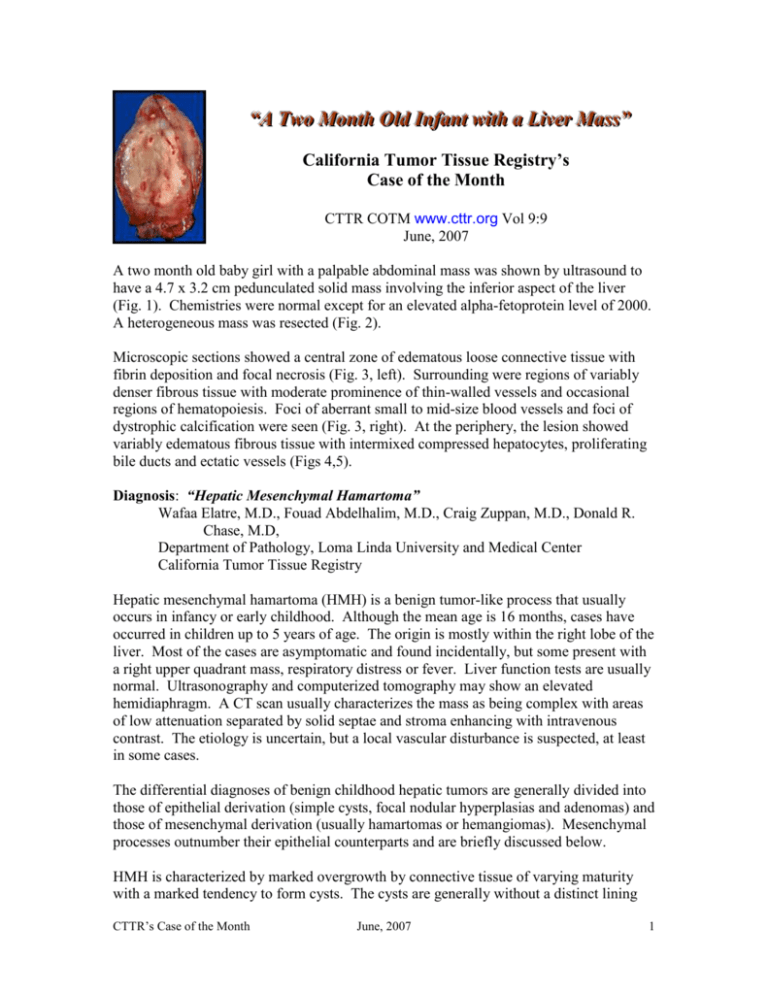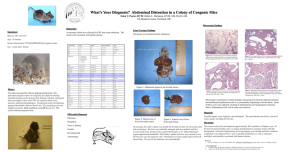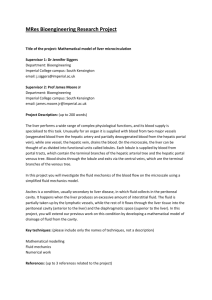COTM0607 - California Tumor Tissue Registry
advertisement

““A A TTw woo M Moonntthh O Olldd IInnffaanntt w wiitthh aa LLiivveerr M Maassss”” California Tumor Tissue Registry’s Case of the Month CTTR COTM www.cttr.org Vol 9:9 June, 2007 A two month old baby girl with a palpable abdominal mass was shown by ultrasound to have a 4.7 x 3.2 cm pedunculated solid mass involving the inferior aspect of the liver (Fig. 1). Chemistries were normal except for an elevated alpha-fetoprotein level of 2000. A heterogeneous mass was resected (Fig. 2). Microscopic sections showed a central zone of edematous loose connective tissue with fibrin deposition and focal necrosis (Fig. 3, left). Surrounding were regions of variably denser fibrous tissue with moderate prominence of thin-walled vessels and occasional regions of hematopoiesis. Foci of aberrant small to mid-size blood vessels and foci of dystrophic calcification were seen (Fig. 3, right). At the periphery, the lesion showed variably edematous fibrous tissue with intermixed compressed hepatocytes, proliferating bile ducts and ectatic vessels (Figs 4,5). Diagnosis: “Hepatic Mesenchymal Hamartoma” Wafaa Elatre, M.D., Fouad Abdelhalim, M.D., Craig Zuppan, M.D., Donald R. Chase, M.D, Department of Pathology, Loma Linda University and Medical Center California Tumor Tissue Registry Hepatic mesenchymal hamartoma (HMH) is a benign tumor-like process that usually occurs in infancy or early childhood. Although the mean age is 16 months, cases have occurred in children up to 5 years of age. The origin is mostly within the right lobe of the liver. Most of the cases are asymptomatic and found incidentally, but some present with a right upper quadrant mass, respiratory distress or fever. Liver function tests are usually normal. Ultrasonography and computerized tomography may show an elevated hemidiaphragm. A CT scan usually characterizes the mass as being complex with areas of low attenuation separated by solid septae and stroma enhancing with intravenous contrast. The etiology is uncertain, but a local vascular disturbance is suspected, at least in some cases. The differential diagnoses of benign childhood hepatic tumors are generally divided into those of epithelial derivation (simple cysts, focal nodular hyperplasias and adenomas) and those of mesenchymal derivation (usually hamartomas or hemangiomas). Mesenchymal processes outnumber their epithelial counterparts and are briefly discussed below. HMH is characterized by marked overgrowth by connective tissue of varying maturity with a marked tendency to form cysts. The cysts are generally without a distinct lining CTTR’s Case of the Month June, 2007 1 but in older children may have an attenuated epithelial lining. Cysts range from microscopic to as large as 15 cm, and have a tendency to be larger in older children. Although the mesenchyme may contain remnants of liver cells, duct cells and even portal tissue, the most characteristic feature is the overgrowth of connective tissue. Lobular architecture is maintained in any normal liver tissue at the periphery of the lesion. Vascular lesions in the differential include infantile hemangioendothelioma and cavernous hemangioma. On CT scan, these tumors are hypodense well-defined homogenous masses sometimes with calcification. Infantile hemangioendothelioma usually presents before six months of age and is more common in females. It may be asymptomatic or present as hepatomegaly, an abdominal mass or as high output cardiac failure. Microscopically the tumor consists of variably sized vascular spaces lined by relatively immature plump endothelial cells. Cavernous hemangioma occurs in all age groups and is often asymptomatic and discovered incidentally. It is usually a solitary lesion with a predilection for the right lobe. It occurs more commonly in females. It consists of multiple dilated blood filled spaces lined by mature flat endothelium and separated by fibrous stroma. With predominantly cystic lesions, the differential diagnosis also includes simple nonparasitic cysts and polycystic liver disease. Simple cysts may be large and have a lining of columnar, cuboidal or flattened epithelium. The wall is generally thin and composed of mature connective tissue and may be calcified. Polycystic liver disease is frequently associated with polycystic renal disease (50%) and/or cystic processes involving the spleen, pancreas, ovaries and/or lungs. Hepatic function is usually normal. For predominantly solid lesions, the clinical differential diagnosis includes primarily hepatoblastoma, which should be readily distinguishable under the microscope by its malignant features and recapitulation of fetal or embryonal hepatocytes. HMH generally carries an excellent long term prognosis. Treatment is surgical with four options including enucleation, marsupialization of cysts, excision of hamartoma with surrounding rim of normal liver tissue and formal hepatic lobectomy. Generally, excision or marsupialization is recommended in most patients because of low morbidity and mortality. Suggested Reading: CTTR’s Case of the Month June, 2007 2 1. Srouji MN, Chatten J, Schulman WM, Ziegler MM, Koop EC. Mesenchymal hamartoma of the liver in infants. Cancer 42:2484-2489, 1978. 2. De Maioribus CA, Lally KP, Kenneth S, Hart H, Hossein M. Mesenchymal hamartomas of the liver. A 35-years Review. Arch Surg; 125:598-600, 1990. 3. Ros PR, Goodman ZD, Ishak KG, Dachman AH, Olmsted WW, Hartman DS, et al. Mesenchymal hamartoma of the liver: Radiologic - Pathologic correlation. Radiol 158:619-625, 1986. 4. Dooley JS, Li AKC, Scheuer PJ, Hobbs KEF, Sherlock S. A giant cystic mesenchymal hamartoma of the liver. Diagnosis, management and study of cyst fluid. Gastroent. 85:958-961, 1983. 5. Suri S. Hepatic masses in children. In: Diagnostic Radiology: Pediatric Radiology, New Delhi, 1st ed. Eds. Berry M, Suri S, Chowdhury V. Jaypee Brothers. Medical Publishers limited, pp 42-51, 1997. 6. Johnston PW. Congenital cysts of the liver in infancy and childhood. Am J Surg; 116: 184-191, 1968. 7. Comfort MW, Gray HK, Dahlin DC, Whitesell FB. Polycystic disease of the liver: A study of 24 cases. Gastroent 20:60-78, 1958. 8. Sherlock S, Dooley J. Cysts and congenital biliary abnormalities. In: Diseases of Liver and Biliary System, 10th ed. Oxford, Blackwell Science, pp 579-591, 1997. CTTR’s Case of the Month June, 2007 3







